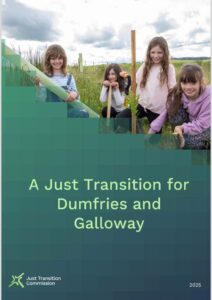To view the full content of the report, please download the PDF below. (An accessible version of the report for screen readers will follow shortly)
A Just Transition for Dumfries and Galloway

Overview
This is the third in our series of written briefings arising from the people- and place-based approach we have adopted over the past year. The previous two short reports within this series focused on Grangemouth and Shetland, and in May findings from Aberdeen will be published. Previously we published a number of pieces of advice on a sectoral basis, aligned with the Scottish Government’s just transition planning for four critical economic sectors: energy, land use and agriculture, transport, and the built environment and construction.
The challenge
The transition to a low carbon economy is happening alongside a set of challenging demographic trends experienced by rural areas of Scotland such as Dumfries and Galloway. A pattern of declining rural populations, as young people seek economic opportunities in towns and cities, runs in tension with an expansion of economic activity in rural areas that is already well underway as new infrastructure is rolled out and enhancements are made to the way our land is used and the fabric of our built environment. Policy, regulation and investment decisions will determine the extent to which local communities benefit from newer forms of economic activity occurring in their area. A marker of just transition may be a renewal of rural communities and progress in reversing the trend of declining rural settlement and the concentration of services and opportunities in urban areas.
Related to these demographic shifts, Scotland is currently experiencing a national housing crisis. The Commission has looked in detail at skills and retrofitting but its programme of engagement in Dumfries and Galloway provided an opportunity to look at housing in a broader sense, as a potential blocker, enabler and measure of progress towards a just transition.
The woodland resource in the South of Scotland is extensive at over 30% cover of the area, with significant forest nursery activity undertaken in the region as part of national tree planting targets. The forestry sector is growing and increasing its demand for forest floor jobs, as well as diversifying and requiring more varied skills. As with other critical sectors, it has an ageing workforce and is experiencing challenges in attracting and retaining young people. As woodland areas expand, how should the fairness or otherwise of these changes be assessed?
Key messages
- Communities should have a stake and say as Scotland ramps up tree-planting to ensure proper custodianship of land. The Climate Change Committee projects 39% of the trees the UK needs to plant between now and 2050 will be in Scotland. A large proportion of this planting is projected to be in Dumfries and Galloway. A purely market-led approach is highly unlikely to succeed in achieving this rapid rate of expansion in a fair way that addresses climate and nature targets, particularly given our highly concentrated pattern of land ownership. To achieve an equitable sharing of costs and benefits and safeguard social cohesion to support delivery, a new mode of community involvement in woodland and forestry management is needed that embeds a community wealth building approach. This could include the introduction of community woodland grants supplements to increase support for community woodland creation and community woodland management. Further mechanisms include community held stakes in forestry developments, evidence of community wealth building via the Forestry Grant Scheme and Woodland Carbon Code, as well as robust accountability mechanisms to ensure transparent reporting and oversight of factors such as environmental impact, biodiversity, public access, and the creation of sustainable local jobs through active management practices.
- Communities do not currently have the capacity or resource to keep pace with developments. Action is required to enhance the capacity and resource of communities to play an active role in shaping changes associated with the climate and nature transition for their locality, such as energy projects and tree planting. There is a consistent asymmetry in capacity between developers and communities which requires to be addressed strategically. A new model for the funding of community development trusts and community-led anchor organisations would be a big step forward. An objective of regional just transition plans, aligned with Regional Land Use Partnerships, should be to identify where communities require support in order to take part in decision-making, share knowledge and benefit from local developments, and how this support should be delivered.
- Partnership working is key for cohesion. Strong relationships between stakeholder groups, including relevant public bodies, need to be sustained, especially where different groups (such as foresters and farmers, for example) are known to hold differing perspectives on common issues, as the basis for social dialogue to foster mutual understanding. Regional Land Use Partnerships clearly have a key role to play in identifying and supporting local priority actions that contribute to national plans and targets, provided they have appropriate capacity and long-term support to operate.
- A just transition means tackling the housing crisis. The lack of adequate housing for people in Dumfries and Galloway, as in many other parts of Scotland, will slow progress in reducing emissions and risks stymying the positive potential impact of the economic opportunities brought by the transition in terms of investment, skills and labour required to reconfigure our land use and install and maintain new infrastructure.